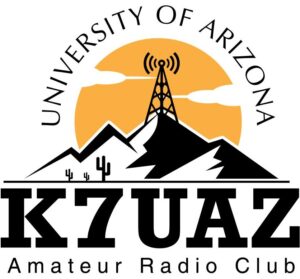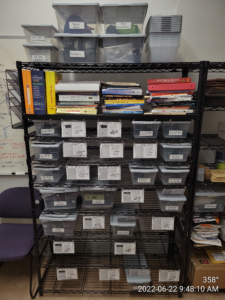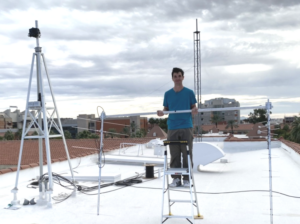A Small Grant Makes a Big Impact for College Club
 At ARDC, we think that both education and amateur radio are important, so what better way to support and promote both than to invest in college amateur radio clubs? Case in point: a modest investment in K7UAZ, the University of Arizona Amateur Radio Club, has paid big dividends. An $8,287 grant in 2021 enabled the club to purchase equipment, including 5 Icom IC-2300 2-meter FM radios, SignaLink digital interfaces, and an Icom IC-9700 VHF/UHF Transceiver. This equipment has helped engage students and get the club moving in the right direction.
At ARDC, we think that both education and amateur radio are important, so what better way to support and promote both than to invest in college amateur radio clubs? Case in point: a modest investment in K7UAZ, the University of Arizona Amateur Radio Club, has paid big dividends. An $8,287 grant in 2021 enabled the club to purchase equipment, including 5 Icom IC-2300 2-meter FM radios, SignaLink digital interfaces, and an Icom IC-9700 VHF/UHF Transceiver. This equipment has helped engage students and get the club moving in the right direction.
According to Hilly Paige, W7HIL, club vice president, the availability of this equipment has spurred several students to get their licenses and join the club. “The club has just exploded with all the upgrades we’ve been able to make to the station.” In 2021, there were only three club members, but now there are 16 on the club roster, according to Sarah Li, K7SLI, club president. “We’re on a really healthy growth curve,” she said.

Students can easily check out equipment by going to this rack in the K7UAZ shack and filling out a card saying that they borrowing it.
Li also noted that making equipment available to students is one of the keys to their success, and that most of the equipment available to students is almost always checked out. For example, in addition to the IC-2300s they purchased with the ARDC grant, the club has six handheld transceivers that they loan out to students. They plan to purchase three more because they anticipate more demand when several of the new members get their licenses.
Station Trustee and Manager, Curt Laumann, K7ZOO, views this as an excellent measure of student engagement with the club. He also pointed to increased participation in the club’s weekly net. According to Laumann, they average four or five student check-ins per week.
The weekly net is more than just a gabfest, though. According to Li, they schedule student members to be the net control station each week. “It’s a great opportunity for the students to learn how to handle traffic on the air, be comfortable with using phonetics, and choose an interesting radio-related topic for discussion,” she said. According to Laumann, it’s this structure that makes the net successful. The net control station not only chooses a topic, but also emails resources to the members to review before the net. Those who check in then can contribute what they know to the discussion.
Upgrading the satellite station
In addition to purchasing the VHF/UHF gear that they loan to students, the club was able to upgrade their satellite station. They purchased an Icom IC-9700 all-mode VHF/UHF transceiver to replace an aging Yaesu FT-736R, and replaced the club’s az-el rotor system. A grant from the university allowed the club to replace the antennas. The result, according to Laumann, is a “modern, highly effective satellite station.”
According to Paige, who is also the chief system engineer for the university’s CubeSat program, the new station is “fantastic.” It allows students to make satellite contacts much more regularly than they could with an HT and handheld Yagi antenna. Paige also noted that the station has helped him gain experience that he’ll be able to use in pursuing a career in signal intelligence after he graduates.
Li pointed out that she feels her work on club projects helped her stay engaged with the club. “Getting involved with the station upgrades is one the reasons I stayed in the club,” she said, “I felt that I was contributing and getting some hands-on experience with the equipment.” When she was handed the manual for the IC-9700 and encouraged to learn how to use it, she was a little hesitant at first, but with encouragement from the station manager and other club members, she was able to make a positive contribution.
“Learning how to use a voltmeter and how a circuit works has been very helpful to me. We deal with similar concepts in neuroscience, so what I learned in the ham radio class was very applicable to what I study.”
Li and Paige are both engineering students, but the club has found that amateur radio appeals to students in other departments as well. For example, Hanna Nkulu, who is now KK7EKD and club treasurer, studies neuroscience. To get her license, she took a Technician class taught by Laumann and Paige and found the class to be very enlightening. Hanna said, “Learning how to use a voltmeter and how a circuit works has been very helpful to me. We deal with similar concepts in neuroscience, so what I learned in the ham radio class was very applicable to what I study.”
Paige noted that some music students have a natural affinity for ham radio, especially Morse Code. He said that the club’s secretary, Tiana Molina, WB7TIA, who is a music major, just started learning Morse Code a month ago and has already sped past him. “I’m kind of jealous,” he said.
“Doubling down”
The club was so successful with their first grant that they applied for a second grant in 2022 for $4,300. The club will use this grant to help students learn how to build antennas and to learn about digital modes and software-defined radios. “The 2022 grant is a ‘doubling down’ of the 2021 grant,” said Paige, “There’s huge interest in digital communications and digital signal processing here. There’s a lot of interest in the high-tech field of amateur radio.” For example, the club recently held a presentation on digital modes, and Li noted, there were only two or three empty seats.
By all accounts, the University of Arizona Amateur Radio Club is on the right track. With a little help from ARDC, they have been able to upgrade their station and attract new members–and they’re just getting started.. We would like to help your college club, too. If you have an idea for a project that will help your college club make an impact, get in touch with us to see how you can qualify for an ARDC grant.
